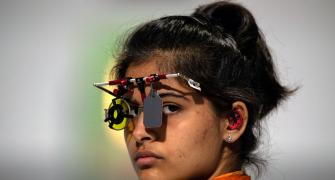The Union ministry of information technology and communications has drawn a blueprint for the rapid growth and development of the hardware sector, including the electronics industry to catch up with the strides made by the software sector.
Unfolding the government's strategy for the 10th Five-Year Plan period (2002-07) at the two-day international conference on "New Vistas of Electronic Manufacturing" in Bangalore, IT department director R C Sachdeva told delegates that the ministry had forwarded some of the pro-active recommendations made by the Kelkar Committee to the Union finance ministry for implementation in the ensuing Union Budget for the fiscal year 2003-04.
"As a facilitator of both the hardware and software sectors of the IT and electronics manufacturing industry, the IT department is determined to ensure a balanced growth of both the sectors.
"Keeping in view the targets set by the 10th Plan and as envisaged by the McKinsey Report, India has to cover a lot of ground to emerge as one of the top 10 manufacturing hubs in the world," Sachdeva stated.
As a first step, the government would be fully implementing the Information Technology Agreement or ITA-1 of the World Trade Organisation by 2005, to introduce zero customs duty on all the 217 items related to hardware
sector that go into the manufacturing of electronic and IT products.
It may be recalled that India is one of the 27 countries to have signed the ITA-1 of the WTO in Singapore in 1996. Though most of the signatory countries have implemented the pact up to 90 per cent by 2000, India had sought time till 2005 to reduce its import tariffs to zero so as to protect and enable its industry to grow and develop global manufacturing standards for being competitive and cost-effective.
"Implementing the ITA-1 in phases, the government has already reduced import duty to zero on 103 items, while retaining varying customs duty from 10-25 per cent on the remaining 114 items, with majority of them at 15 per cent," Sachdeva disclosed.
Among the several far-reaching recommendations made by the Kelkar Committee, the IT ministry has favored:
- To eliminate multiplicity of customs levies and bring it to three slabs of 0, 10, and 20 per cent.
- To remove end use base exemptions.
- To eliminate multiplicity of central excise duty levies.
- Simplification of customs/central excise duty procedures and trade facilitation.
- Harmonisation of commodity classification to 8-digit codes.
- Simplification of export-oriented schemes, and
- Simplification of corporate tax structure and procedures related to direct taxes.
"The IT department has, however, disagreed with the recommendation to withdraw all incentives on exports.
"In order to ensure level-playing field, tax incentives to software/hardware exports should be continued. Similarly, all imports should be levied CENVAT and state VAT duties to make them Modvatable in the run-up to implementing the composite value added tax.
"We have also recommended that there should be no bonding of exported-oriented units, software technology park units, and electronic or hardware technology park units," Sachdeva affirmed.
To reverse the prevailing inverted tax structure in the industry, the IT ministry has also favored the reduction of customs duty to zero on all inputs that go into the manufacturing of electronic components and capital goods for electronic and hardware sectors.
Excise duty on electronics and IT hardware products should also be reduced to a uniform rate of 8 per cent. The existing tariff structure on capital goods varies from 15-25 per cent; on raw materials/inputs 0-30 per cent; on components 0-15 per cent and on finished goods, it is between 15-30 per cent.
Customs duty on capital goods for IT/electronic components in many countries such as Brazil, China, the European Union, Japan, Malaysia, Mexico, Philippines, Singapore, Taiwan, and the US is zero as against 15-25 per cent in India, increasing the cost of production and non-competitive in export markets.
Similarly, import tariff on raw materials in many of the competing countries ranges between 0-5 percent, while it is hovering between 0-30 per cent.
Referring to the reports of the IT Task Force on hardware and software sectors, constituted by the Prime Minister's Office under the chairmanship of Union Finance Minister Jaswant Singh, when he was heading Deputy Chairman of the Planning Commission in 1998-1999, Sachdeva said while most of the recommendations on the software sector have been implemented so far, those on the hardware sector were being taken up in phases now.
"The government is committed to have a vibrant manufacturing base for hardware in the country. Some of the measures underway are: to create demand through reduction in prices by increasing volumes, as being witnessed in the telecom sector (basic and mobile services); IT industry (PCs, servers, modems, network equipment) and consumer electronics
(TVs, home appliances, and white goods).
"Secondly, by increasing the use of IT and electronic products by various government departments at the Centre and state levels to usher in e-governance will shoot up their demand, leading to corresponding increase of their services for the end-users, including the citizens and the private sector," Sachdeva asserted.
Besides generating huge employment and improving the quality of life, including literacy, healthcare, communications, etc, the thrust towards a balanced growth of hardware and software sectors will boost exports and share of the Indian products in the global market.
Keeping in view the growth and demand in the next five years, the Planning Commission has set production targets for the final year of the plan period (2006-07). Production for hardware is projected at Rs 69,000 crore (Rs 690 billion) as against Rs 32,750 crore (Rs 327.5 billion) achieved during the preceding fiscal year (2001-02).
In the case of software targets, production for the fiscal year 2006-07 is estimated to be Rs 160,000 crore (Rs 1,600 billion) in exports as against Rs 36,500 crore (Rs 365 billion) in 2001-02, and Rs 53,000 crore (Rs 530 billion) as against Rs 11,634 crore (Rs 116.34 billion) in domestic market.
The total software production target is Rs 213,000 crore (Rs 2,130 billion) for the year 2006-07 as against Rs 48,134 crore (Rs 481.34 billion) during the fiscal year of 2001-02.
The total production target of hardware and software segments is projected to be Rs 282,000 crore (Rs 2,820 billion) as against Rs 80,884 crore (Rs 808.84 billion) achieved in the fiscal year 2001-02.







